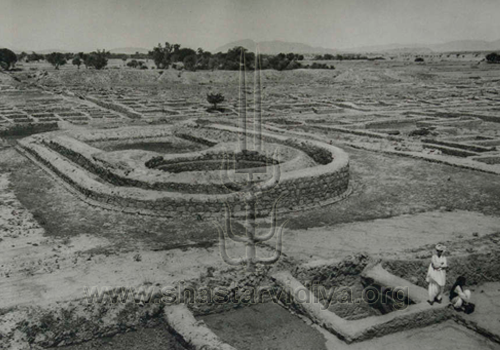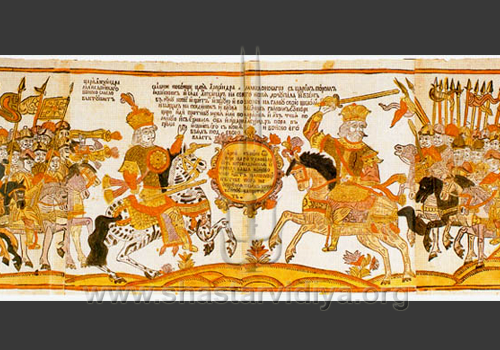"�known for its schools of Law, Medicine, and Military Science..."
(Chandragupta Maurya And His Times)
From the realms of pre-history and mythology, as recounted by scripture and oral tradition, the transmission of the Sanatan Shastar Vidiya now takes its first tentative steps onto the historical grounds of Taxila. As the gloriously multifaceted and all-embracing Hindu culture evolved, the earlier Indian sages known as the 'Munivar', had split into two groups: 'Shivite' (followers of Shiva), and the 'Vaishnava' (followers of Vishnu). This was the golden age of peace and tranquillity, largely brought about by Lord Raam's rule.� Whilst in the pursuit of self-cultivation and guarding Dharma, these sages further developed the martial art skills which they had inherited from the earlier Munivar. Extra impetus was provided through the odd martial genius. The focal point of these innovations was Taxila, an ancient city located in West Punjab, the ruins of which today lie in Pakistan (approximately 22 miles from Rawalpindi).
"Taxila, the intellectual capital of the Indian continent, from the different and distant parts of which there was a steady movement of qualified students from all classes and ranks of society towards Taxila, to complete the education they had in the schools of their native places. Thus the various centres of learning in the different parts of the country became affiliated, as it were, to the educational centre, or the central university, of Taxila which exercised a kind of intellectual suzerainty over the wide world of letters in India."
(Radha Kumud Mookerji, Ancient Indian Education, Brahminical and Buddhists, (Motilal Banarasidass Publications, 2003), 478)
The Ramayana recounts that Raam's brother Bharat established the city of Taksa in the North of India. Bharat had named the city after his son Taks, a powerful 'Kshatriya' (traditional Hindu warrior) and devotee of Shiva. According to legend, he is believed to have possessed a mantra which gave him power over the 'Naga' (snakes). In his accounts of the mythological battles of the Hindu demigods and demons, Guru Gobind Singh speaks of the king of Naga, Taksh (Taks):
"...he is described as a warrior in the army of gods led by Mahakal."
(Sarbloh Guru Granth Sahib, 2:5:27)
The city of Taksa was known by the Greeks as Taxila, whilst the Romans speak of it as Taxilla, and the Chinese as Chu-ch'a-shi-lo. The name Taxila roughly translates as 'Prince of the serpent tribes'.
Taxila quickly became the centre for learning � including a haven for martial arts in India. It was at Taxila that Sanatan Shastar Vidiya was systemised; thus came into being the ten 'Yudhan' (combat styles) of the art. The ancient Pashupati and Aryan-reconciled Kapalika came and settled in Taxila. Here they dispensed their knowledge and formidable skills. These Munivar sages became the Gurus to the traditional Hindu warrior caste of India, the Kshatriya. For hundreds of years this caste ruled numerous kingdoms in India but in time they succumbed to internecine warfare.�
The recorded history of Taxila begins in the 6th century BC as Gandhara. This Indian kingdom in which the city was situated came under the rule of the Archaemenian (Persian) King Darius I. In time, Taxila transitioned from a Hindu city into a Buddhist-Hindu city and developed into a great learning centre of the ancient world. Students and masters came from afar afield as China, Persia, Rome, Greece, Egypt, Ethiopia etc., to Taxila. Alongside their Indian counterparts, the region became a great melting pot of Eastern and Western learning:
"�known for its schools of Law, Medicine, and Military Science."
(Radha Kumud Mookerji, Chandragupta Maurya And His Times, Motilal Banarasidass Publications, 1952, Pa. 17)
The learned Buddhist monks of Gandhara travelled across to China via the Silk Road, taking with them their wisdom, including the Indian martial arts.� The martial arts had no doubt been influenced by interaction with the ancient civilisations of the Egyptians, Greeks, Persians, Romans, and those originating from China. It is from Taxila that this martial knowledge was disseminated throughout the East. Over time, these martial arts interacting with indigenous fighting arts and morphed into a myriad of new forms; influenced by their new surrounding environments and cultures.
The demise of Taxila came in the 5th century A.D. when it was horrifically ransacked by the White Huns of central Asia. They devastated the region of Gandhara, and Taxila remained no more. In the 7th century, a Chinese traveller named Hsuan-tsang, visited the city of Taxila and recorded that it lay in complete ruin. Subsequent records make no mention of Taxila. Eventually, the Indian masses rose up and defeated the Huns largely led by the Jat and Gujar tribes; they were driven out of the region.� In time, a new warrior order of the 'Rajputs' (literally sons of kings) would emerge in India. Modelled upon the ancient Kshatriya warriors such as Lord Raam, this order would be established by the 'Brahmins' (Aryan priests).



